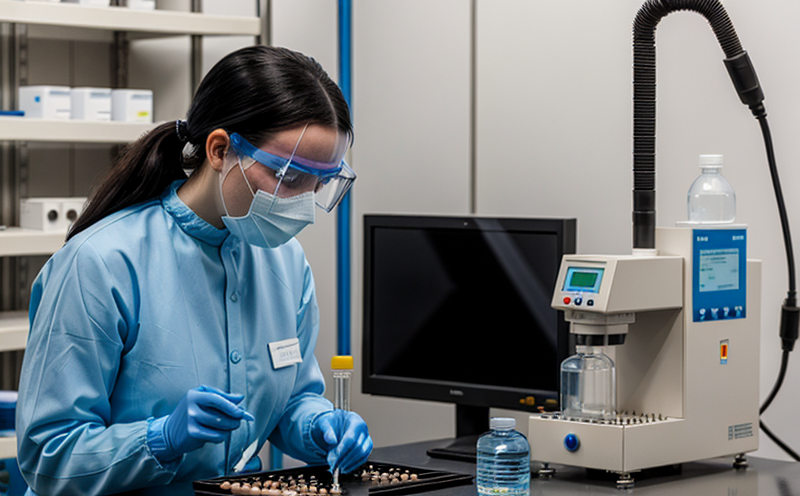PCB Impurity Profiling Testing
The process of PCB impurity profiling is critical in ensuring the quality and safety of pharmaceutical products. Polychlorinated Biphenyls (PCBs) are a group of chlorinated hydrocarbons that were widely used until their production was banned due to environmental and health risks. Despite being banned, traces of PCBs can still be found in various materials, including those used in the manufacturing of pharmaceuticals.
Chemical characterization and impurity profiling play a pivotal role in identifying and quantifying these trace contaminants within pharmaceutical formulations. This testing ensures that the final product meets stringent regulatory requirements and does not pose any risk to consumers. The importance of this service lies in its ability to provide comprehensive data on the presence, concentration, and nature of PCBs, which can significantly impact drug efficacy and safety.
The testing process involves several key steps, including sample preparation, extraction, purification, and analysis using advanced analytical techniques such as High-Performance Liquid Chromatography (HPLC) coupled with Mass Spectrometry (MS). These methods allow for the detection of trace amounts of PCBs down to parts per billion levels. The precision and accuracy of these tests are paramount in maintaining the integrity of pharmaceutical products.
Regulatory compliance is another critical aspect of PCB impurity profiling testing. Regulatory bodies such as the U.S. Food and Drug Administration (FDA), European Medicines Agency (EMA), and others have established guidelines and standards for the detection and control of PCBs in pharmaceuticals. Adhering to these regulations helps manufacturers ensure that their products are safe, effective, and reliable.
The results of PCB impurity profiling testing can be used by quality managers, compliance officers, and R&D engineers to make informed decisions about product development, manufacturing processes, and ingredient sourcing. For procurement teams, this information is invaluable in selecting suppliers who adhere to strict quality standards.
Why It Matters
The importance of PCB impurity profiling testing extends beyond mere compliance with regulations; it plays a vital role in safeguarding public health. The presence of even minute amounts of PCBs can have serious health implications, including developmental disorders and increased risk of cancer. Therefore, ensuring the absence or minimal levels of these contaminants is not just an ethical responsibility but also a legal obligation.
From a manufacturing standpoint, minimizing PCB contamination helps in maintaining product consistency and reliability. Consistent quality is crucial for pharmaceutical companies, especially those involved in clinical trials and large-scale production. Any deviation from expected standards can lead to delays, recalls, and significant financial losses.
The impact of PCB impurity profiling testing on the environment cannot be overstated. By identifying and eliminating sources of PCB contamination, manufacturers contribute to environmental conservation efforts. This not only enhances corporate social responsibility but also fosters a reputation for sustainability among consumers and stakeholders.
For patients, ensuring the purity of pharmaceuticals is essential. Reliable and safe medicines are paramount in treating various health conditions effectively. The assurance provided by rigorous testing processes like PCB impurity profiling can instill confidence in both healthcare professionals and patients.
Scope and Methodology
| Step | Description |
|---|---|
| Sample Preparation | Involves the collection of representative samples from the pharmaceutical product. This step ensures that the sample accurately reflects the batch being tested. |
| Extraction and Purification | Utilizes solvents and chromatographic techniques to extract PCBs from the matrix, followed by purification processes to isolate them for analysis. |
| Analysis | Involves the use of HPLC-MS/MS to detect and quantify PCB congeners. This method provides detailed information on the specific types and concentrations of PCBs present. |
| Data Interpretation | Analyzes the raw data obtained from the analysis, ensuring that it meets regulatory requirements and is suitable for reporting. |
The methodology employed ensures high accuracy and precision in detecting even trace amounts of PCBs. Compliance with international standards such as ISO 17025 guarantees the reliability and validity of the test results.
Industry Applications
Pharmaceutical R&D: To ensure that new formulations do not contain harmful contaminants before they reach clinical trials or market release.
Manufacturing Quality Control: Continuously monitor production batches for any trace levels of PCBs to prevent contamination.
Supplier Evaluation: Assess the quality and reliability of raw materials sourced from suppliers by conducting impurity profiling tests.
Regulatory Compliance Audits: Prepare for and pass regulatory inspections by providing comprehensive test reports on PCB content.
The versatility of this testing ensures that it is applicable across various stages of pharmaceutical development and production, making it an indispensable tool in the industry.





